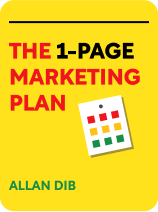

This article is an excerpt from the Shortform book guide to "The 1-Page Marketing Plan" by Allan Dib. Shortform has the world's best summaries and analyses of books you should be reading.
Like this article? Sign up for a free trial here .
What does it mean to prospect customers? How can you identify potential customers?
Prospecting customers is the first step in an effective marketing strategy. It involves identifying your target audience and developing a strategy for turning them into paying customers.
Keep reading to learn about the three steps of prospecting customers.
What Is Customer Prospecting?
In the first marketing phase, you should focus on prospecting customers.
This involves focusing on those who’ve likely never heard of your business—prospects—so that they will discover you and respond to an offer, thereby becoming leads and entering the second phase. (Shortform note: As noted earlier, each marketing phase entails three steps. To create your own 1-page plan, fill in each step or square on the author’s or your own nine-square template as you read this guide.)
The three steps for prospecting customers are:
- Identify your target market.
- Develop a compelling message for this market.
- Deliver the message through some type of direct advertising.
Here are the three steps of prospecting customers in more detail:
1. Identify Your Target Market
To prospect customers, begin by identifying your target market. By identifying and focusing your marketing on the prospects most likely to buy from you, according to Dib, you’ll receive a better ROI or return on investment for your time, money, and effort.
As noted earlier, many small businesses try a mass marketing or branding approach of broadcasting their name widely and frequently in hopes that a small percentage of those who hear it will become customers. However, this type of marketing is costly and results are hit or miss. Dib recommends focusing narrowly on a single niche or subset of your market at a time.
(Shortform note: Similarly, in The 21 Immutable Laws of Marketing, the authors note that many businesses mistakenly believe that appealing to a wider audience will expand their customer base. However, the way to expand your customer base is actually to identify and focus on your strongest niche, because success in a niche expands the niche and beyond. For example, in advertising cigarettes, Marlboro targeted only men while other companies sought to attract both men and women. With its memorable campaign featuring cowboys, Marlboro led sales nationally among both men and women.)
Dib notes that you can keep serving multiple market niches, but he advises focusing your marketing on one ideal segment first—characterized by people you genuinely like working with, who value what you offer and are willing to pay a premium for it, and who exist in sufficient numbers to make the work profitable. After dominating your first niche, then target another niche.
You can also create niche profiles, including characteristics such as age, gender, education, income, and geographic location. In addition, delve deeper by researching and interviewing people in this market.
(Shortform note: An Inc. article offers more detailed steps for identifying your target market by analyzing the following: your customer base, competition, your product or service, the most-promising demographic, and their concerns, attitudes, and behaviors.)
2. Create a Compelling Message
Once you’ve identified your target prospects, step 2 of prospecting customers is crafting a message that gets their attention (so they react, “Hey, that’s just what I need!”) and compels them to act. Dib offers several tips to create such a message.
(Shortform note: Dib stresses that the purpose of direct-response advertising is to generate leads, or potential future customers, rather than to sell immediately, but his tips seem aimed at creating messages that sell, so it’s likely the two purposes overlap.)
1) Develop a unique selling proposition: Your ads should flow from your unique selling proposition, a concise problem-solution statement that tells prospects why they should buy from you rather than from a competitor. Dib contends your USP should position you so that prospects make an apples-to-oranges comparison between you and your competition rather than apples-to-apples. Your differentiator could be your product, or something else like packaging, delivery, or support.
2) Create a compelling offer: Once you know your niche and USP, you need to structure an offer that will excite your target prospects. Don’t go the lazy route of just offering a discount, or customers will default to an apples-to-apples price comparison. Dib identifies several essential elements of a compelling offer:
- Add customer value by bundling additional benefits and bonuses (the way infomercials do).
- Justify your offer (for example, overstock) so prospects don’t fear it’s too good to be true.
- When a customer is in a buying mood, add on a high-margin item like a service contract.
- Offer no-hassle payment options that work for the customer.
- Offer an extraordinary guarantee that eliminates the customer’s risk that the product won’t meet expectations.
- Suggest scarcity (for example, a limited supply or sale expiration).
(Shortform note: In addition to these often-quoted basic elements, being extra creative with your offer can significantly boost your response rate. For example, a car dealer might offer an exclusive preview of its newest models to high-end clients—including catered food and a limo ride to the event. The key is to make your offer entertaining and unique (“May I send a limo to pick you up?”) Ask yourself whether the offer you’re contemplating would motivate you to act if you received it. This marketing website provides additional examples of compelling offers for various types of products.)
3. Choose the Right Medium for Your Message
The third step of prospecting customers is choosing the right advertising medium to communicate your message to your target prospects.
Because advertising is the most expensive component of your marketing, Dib recommends choosing and managing it based on ROI, or how many leads and customers it generates versus the cost. By tracking results, you can drop ads that aren’t effective and boost the ones that work. Tools for tracking ad response include toll-free numbers, web analytics, and coupon codes.
To choose a medium or channel (such as direct mail/print, TV/radio, email, social media, or web/SEO), identify and go where your target prospects spend their time. Dib cautions that marketing via social media, while popular, has downsides: It’s time-consuming to monitor and you’re at the mercy of the platform, which owns your social media profile and page.
(Shortform note: As Dib notes, each medium has advantages and disadvantages. Some questions for small businesses to weigh in choosing media include: What do I want this marketing effort to accomplish, where do my target prospects go for information, what information do I want to convey and when, and what’s my budget?)

———End of Preview———
Like what you just read? Read the rest of the world's best book summary and analysis of Allan Dib's "The 1-Page Marketing Plan" at Shortform .
Here's what you'll find in our full The 1-Page Marketing Plan summary :
- How to create a marketing plan using a simple template
- A guide to the three customer-focused phases of marketing
- How to create enthusiastic superfans—and why they're essential






